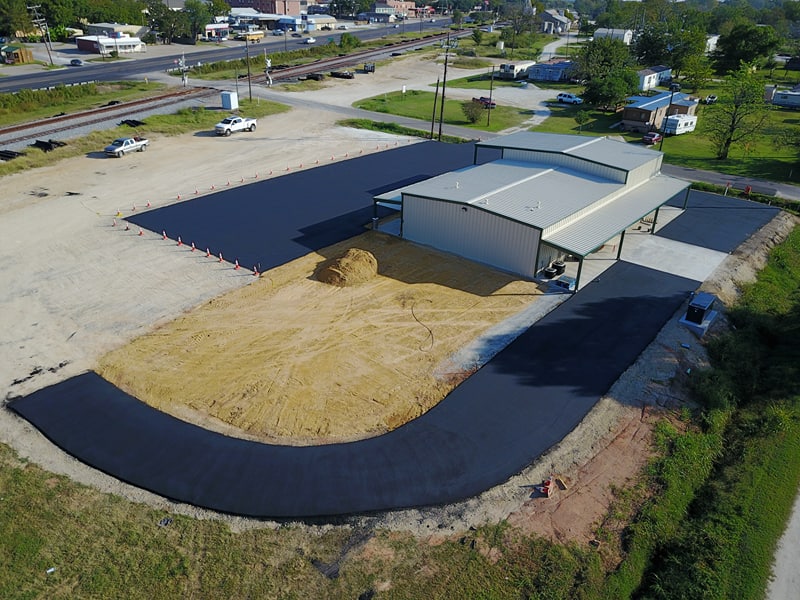Parking Lot Paving
Parking Lot Paving Essentials: A Guide to Durable Surfaces
Parking lot paving is a critical aspect of urban development and commercial space management. It involves the creation of durable surfaces where vehicles can be parked. The materials used for parking lots vary, ranging from asphalt and concrete to gravel and innovative green paving solutions. These materials are selected based on factors such as cost, durability, and the environmental conditions of the area. Asphalt, for instance, is popular due to its cost-effectiveness and relatively simple maintenance requirements.
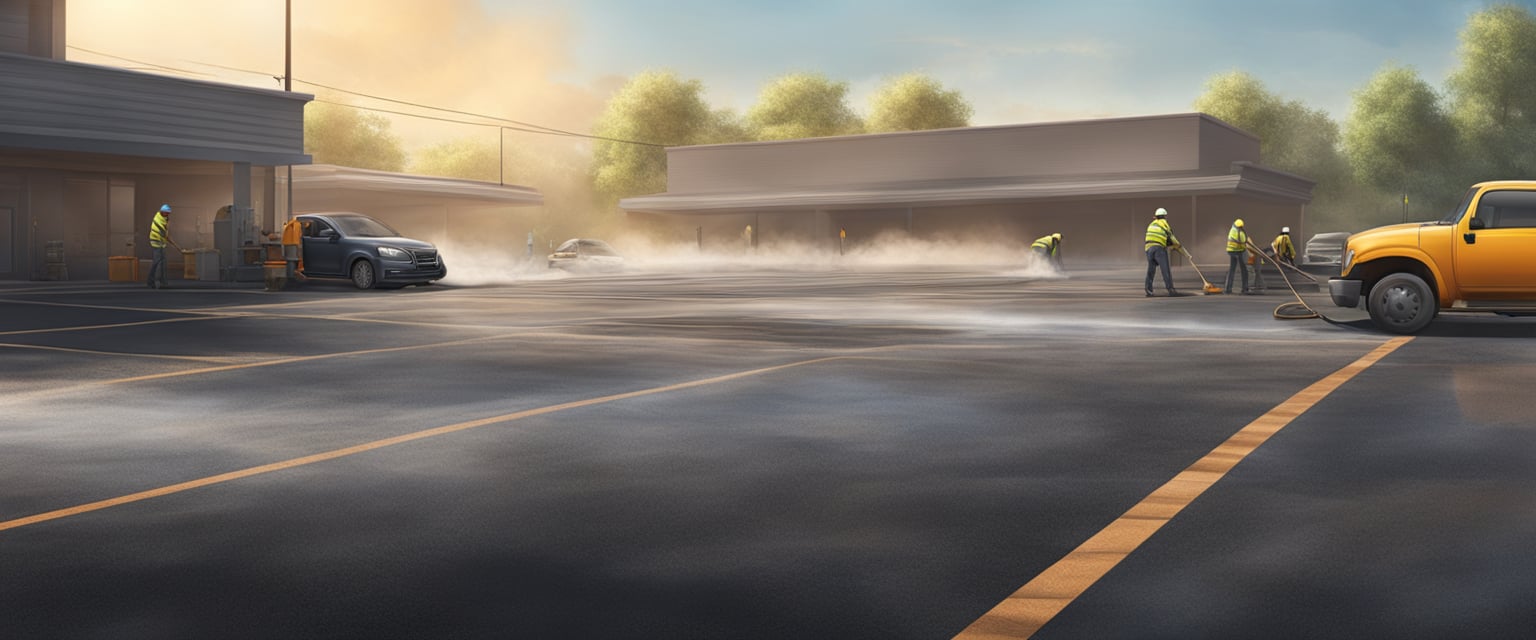
The design and planning of a parking lot take into account the anticipated traffic, the load of parked vehicles, and drainage requirements to prevent water pooling. Safety and compliance with local regulations are paramount to ensure that the parking lot is accessible and safe for all users. This stage is followed by the actual construction process, which must be performed by skilled contractors to meet quality standards. Once completed, a well-designed parking lot not only adds to the aesthetic appeal of the space but also enhances the functionality and flow of traffic.
Key Takeaways
- Parking lot paving enhances the functionality and aesthetic appeal of commercial spaces.
- Material selection for paving is influenced by factors such as durability and environmental conditions.
- Proper design, safety, and compliance are crucial to ensure longevity and usability of parking areas.
Materials for Parking Lot Paving

When constructing or refurbishing a parking lot, the choice of material is crucial, impacting cost, durability, and maintenance. Each paving material has distinct properties suited to specific needs and environmental conditions.
Asphalt
Asphalt is a widely used material for parking lot paving due to its balance of cost-effectiveness and durability. It consists of an asphalt mix made from aggregate, sand, and liquid asphalt cement. This combination provides a smooth, solid surface that can withstand the heavy load of vehicular traffic. An asphalt paved parking lot tends to be easy to maintain, although it is not the most environmentally friendly option.
Concrete
Concrete is praised for its longevity and strength, often outlasting asphalt when used as a material for parking lot surfaces. It is an amalgamation of cement, stone aggregate, and sand, creating a robust and rigid surface ideal for areas with extreme temperatures or heavy vehicles. Although concrete paving can be more expensive upfront, it offers low maintenance costs over time. Moreover, concrete parking lots are a favorable eco-friendly option as they reflect more light and reduce urban heat effects.
Gravel
Gravel consists of small stone or aggregate pieces and presents an affordable parking lot solution. This material is especially suitable for low-traffic areas and temporary setups. It is permeable, thereby allowing water to filter through and reducing runoff issues. Gravel surfaces, however, may require more frequent maintenance to manage dispersion and ruts. Additionally, gravel is not ideal for high-traffic areas, as it can shift and cause uneven surfaces.
Pavers
Permeable pavers represent an environmentally friendly paving solution. Unlike solid paving surfaces, pavers allow water to percolate through, reducing runoff and the risk of flooding. They come in various materials, such as concrete and stone, and can even be made from recycled plastic. Permeable pavers have gained popularity not just for their eco-friendly aspects but also for their aesthetic appeal and design versatility. Despite higher initial costs, their durability and low maintenance requirements make them a cost-effective choice in the long run.
Design and Planning
An effective parking lot design strikes a balance between maximizing space and ensuring safe, durable infrastructure. Critical components such as drainage systems, adequate parking lot size, and aesthetics and landscaping are integral to a successful layout, influencing everything from functionality to curb appeal.
Drainage Systems
Proper drainage is critical to the longevity of a parking lot. A well-designed drainage system prevents water accumulation, which can lead to surface damage and subgrade deterioration. Slopes and drains should be planned to direct water away from parking spaces and toward collection points or storm sewers, ensuring that moisture does not compromise the structural strength of the pavement.
Parking Lot Size
The size of the parking lot must accommodate the expected vehicle traffic while adhering to local zoning regulations. Size considerations include the number of spaces, the dimensions of each space, and adequate clearance for cars to maneuver. The layout should allow for safe pedestrian movement and efficient flow of traffic, with clear markings for stalls and directional flow to minimize confusion.
Aesthetics and Landscaping
Incorporating aesthetics and landscaping enhances the curb appeal and creates a welcoming atmosphere. Strategic placement of green spaces, choice of plants, and the integration of lighting elements not only improve the visual appeal but can also guide traffic and increase safety. Attention to detail in these areas reflects positively on the property and can add to its value.
Cost Considerations
In evaluating the financial outlay for paving a parking lot, it’s imperative to appraise the initial installation cost, ongoing maintenance expenses, and future costs associated with repair and resurfacing. These expenditures vary based on pavement thickness, materials used, and the size of the area to be paved.
Initial Installation Cost
The initial cost of paving a parking lot largely depends on the choice between asphalt and concrete materials. Asphalt parking lots typically range from $2.50 to $4.50 per square foot, whereas concrete alternatives may cost between $4 and $7 per square foot. Variables such as local labor costs and the size of the parking lot significantly influence the total budget.
- Asphalt Parking Lot Cost: $2.50 – $4.50 per sq ft
- Concrete Parking Lot Cost: $4 – $7 per sq ft
Maintenance Costs
Regular maintenance is vital to prolong the lifespan of a parking lot. Budgeting for maintenance costs involves considering routine cleaning, painting parking lines, and sealing cracks to prevent water penetration and damage. On average, maintenance may include:
- Regular Cleaning: Frequency depends on the volume of vehicles
- Line Painting: To ensure visibility and compliance with local codes
- Crack Sealing: Critical to prevent further damage
Maintenance operations and the consequent expenses hinge on the type of material used and the vehicular traffic the parking lot encounters.
Repair and Resurfacing Costs
Over time, a parking lot will require repairs and eventually resurfacing to address normal wear and tear. For asphalt surfaces, this can be necessary every 10 to 15 years. The cost of these interventions fluctuates based on the extent of the damage and the necessary pavement thickness for the repairs. Early repairs such as filling potholes or resealing can extend the duration between major resurfacing projects, thus impacting long-term expenses.
- Minor Repairs: Variable, depending on damage severity
- Resurfacing: Required periodically, influenced by initial pavement quality and thickness
It is critical for property owners and managers to plan for these future costs to ensure the longevity and functionality of the parking facility.
Construction Process
The construction of a parking lot involves a series of methodical steps designed to ensure durability and a smooth finish. From preparing the sub-base to the final touches in curing, every phase is carried out with precision to set the foundation for a quality parking lot.
Sub-Base Preparation
The first step in parking lot paving is preparing the sub-base, which is crucial for a stable pavement structure. This involves removing any existing pavement and ensuring the soil underneath is stable and well-compacted. Techniques such as adding aggregates and proper grading are critical for drainage and a firm foundation. For durability, the materials used must provide adequate support for the asphalt layer above.
Mixing and Pouring Materials
The next phase involves the accurate mixing of asphalt binder and aggregates. This mixture is then transported to the site, where it is poured into the prepared area. Uniform distribution is key, which is typically achieved using a screed to level the asphalt mix before compaction. The installation time for this step is dependent on the size of the area and the complexity of the pavement construction.
Compaction and Curing
After pouring the asphalt mix, rollers are used to compact the material, eliminating air voids and ensuring a dense, uniform surface. Joints are also carefully managed for continuity. Curing of the asphalt is necessary for the material to set and harden. During this stage, it’s important to keep traffic off the new pavement to prevent deformations and ensure a long-lasting parking lot.
Through these steps, with an emphasis on proper technique and timing, parking lot installation establishes a safe and functional surface fit for vehicle loads and traffic patterns.
Maintenance and Durability
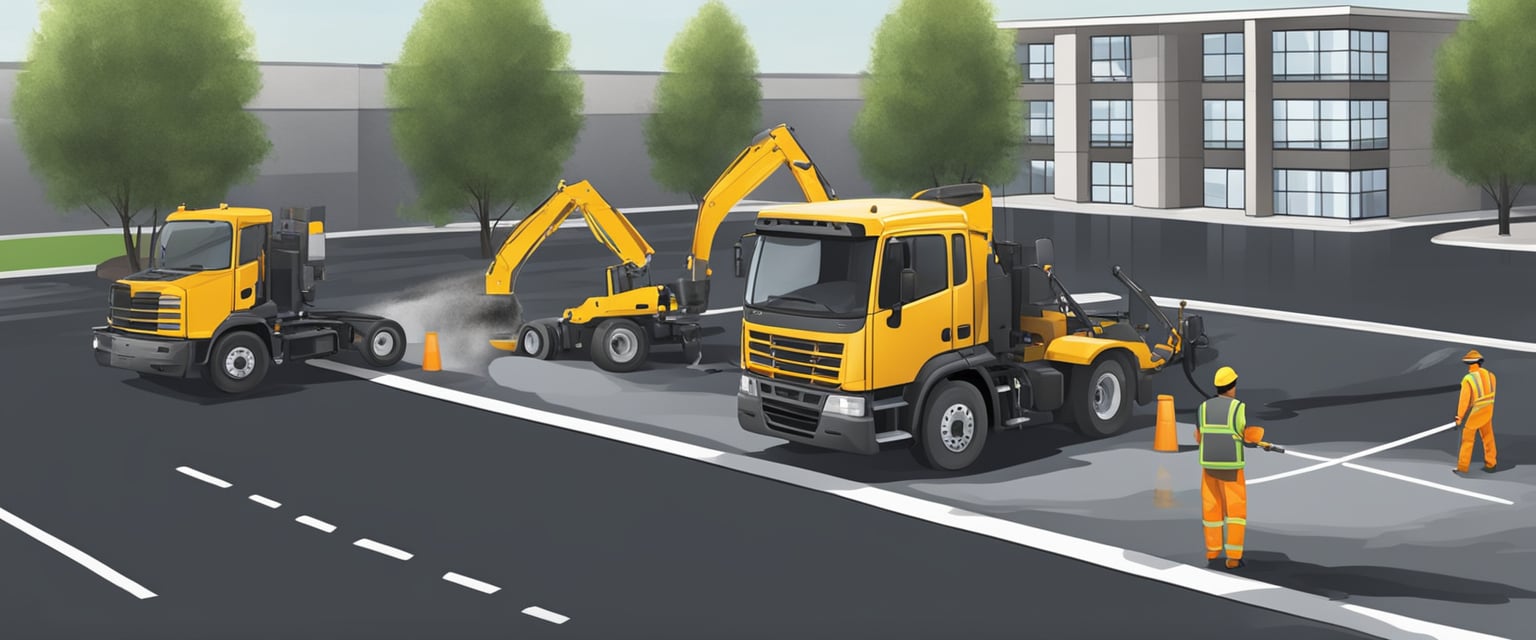
Effective maintenance is crucial for enhancing the durability of asphalt parking lots. Regular upkeep not only prolongs the lifespan but also helps mitigate pavement failures due to heavy traffic and weather conditions.
Regular Maintenance
Regular maintenance is fundamental for preserving the integrity of asphalt parking lots. Cleaning should be conducted routinely to remove debris and prevent surface deterioration. They must also ensure proper drainage is in place to avert water-related damage.
Sealcoating and Sealing
Sealcoating is a preventive measure that significantly extends the life of asphalt surfaces by providing a protective layer. To maintain maximal longevity, a fresh sealcoat should typically be applied every two to three years, depending upon usage and climate conditions. This practice guards against oxidative damage from the sun and chemical corrosion from automotive fluids.
Dealing with Cracks and Potholes
Addressing cracks and potholes promptly is essential to prevent further asphalt repair costs and maintain a safe environment for vehicles and pedestrians. Quality pavement repair techniques involve sealing cracks to prevent water infiltration and employing either patching or full-depth repair for larger potholes to restore surface uniformity.
Safety and Compliance
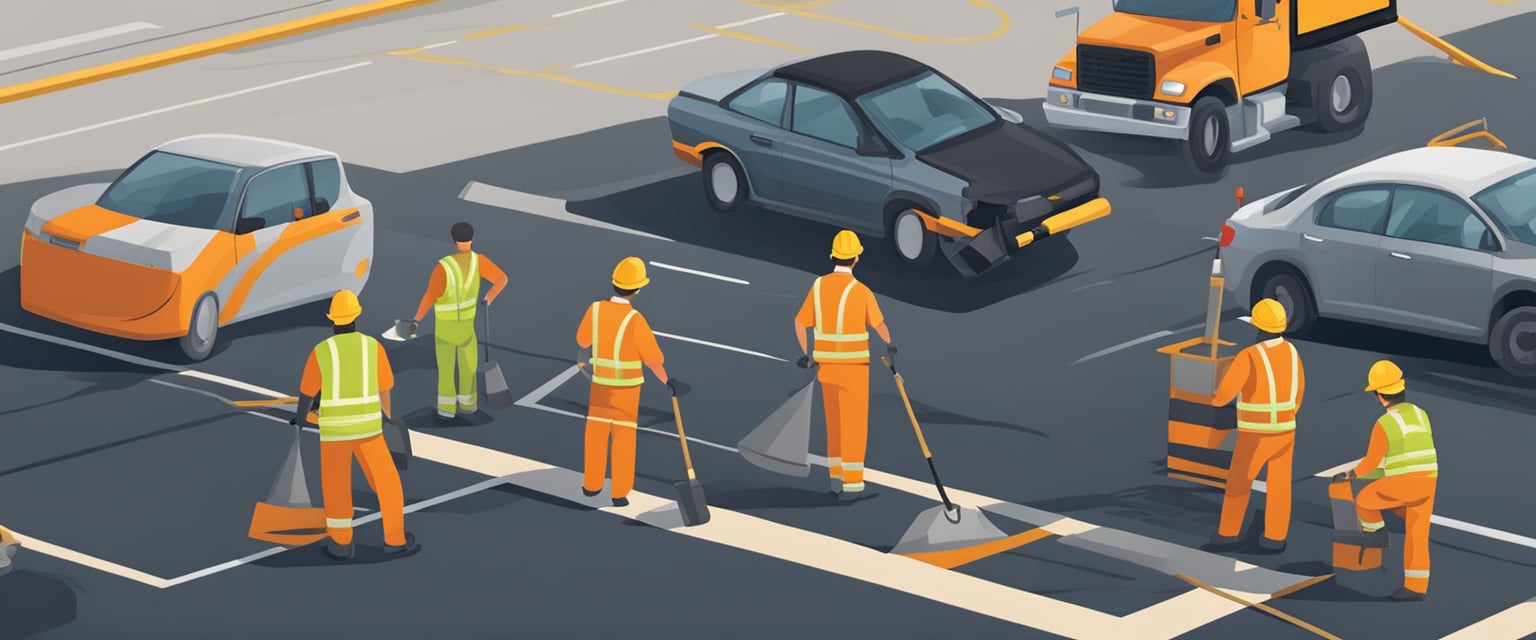
Ensuring a safe and compliant parking lot is essential for property owners and business operators in the USA. Compliance with federal and local regulations is mandatory, and safety for all users is a priority.
Compliance with Regulations
The Americans with Disabilities Act (ADA) sets forth clear guidelines for parking lots to ensure accessibility. These include the number of handicapped-accessible parking spots, the size of parking spaces, and proper signage. The Ultimate Guide to ADA Compliance for Parking Lots offers comprehensive information on federal requirements. Failure to adhere can result in significant legal ramifications and fines.
Additionally, it’s crucial for parking lots to comply with local building codes that may have additional requirements beyond the ADA. These can pertain to the pavement materials used, the paint for marking parking spaces, and the installation of wheel stops or barriers.
Ensuring Safety for Vehicles and Pedestrians
Vehicle and pedestrian safety in parking lots hinges on well-thought-out design and maintenance. Properly marked lanes, visible walkways, and adequate lighting are necessary to prevent accidents. Consistent pavement maintenance addresses potential hazards such as potholes or cracks that could cause trips or damage to vehicles.
In terms of pedestrian safety, Safety and ADA Compliance: How to Ensure Your Parking Lot Meets Regulations underlines the importance of clear and safe pathways, with a special focus on those with disabilities. It is the responsibility of the property owner to ensure the walking surfaces are even and free of obstructions that could impair safety.
Innovative Paving Solutions
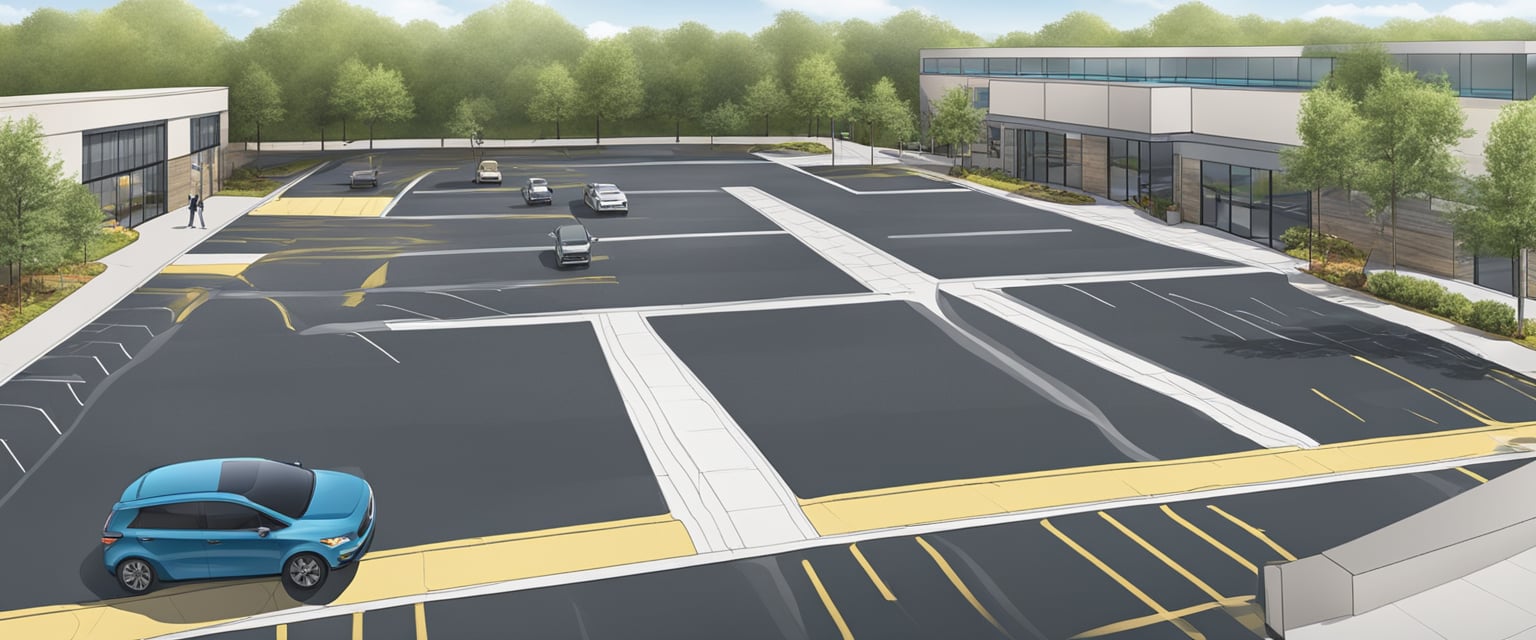
In the realm of paving, innovative solutions are paving the way towards sustainability and improved performance. These advances not only address environmental concerns but also deliver cost-effective and versatile pavement structures.
Eco-Friendly Options
Porous Pavers: One of the most significant advancements in eco-friendly paving is the use of porous pavers. These systems allow for rainwater to percolate through the pavement structure, reducing runoff and promoting groundwater recharge. Companies like Invisible Structures offer durable and low-maintenance permeable grid paver solutions for parking lots, emphasizing eco-friendliness in their design.
Cold Mix Asphalt: Cold mix asphalt is a more environmentally friendly alternative to traditional hot mix asphalt, as it does not require high temperatures for application. This translates into lower energy consumption and fewer emissions. It’s versatile for rural roads and small repairs, proving a cost-effective method for maintaining pavement integrity.
Technological Advancements in Paving Materials
Self-Healing Asphalt: A notable innovation in paving materials is self-healing asphalt, which incorporates specific additives that enable the asphalt to repair itself when cracks appear. This technology not only extends the lifespan of roadways but also reduces maintenance costs over time.
Warm Mix Asphalt Technologies: In addition to self-healing asphalt, warm mix asphalt technologies are setting new standards in paving. By lowering the temperature required to mix and lay asphalt, these technologies cut back on fuel consumption, making the process more cost-effective and environmentally friendly.
Smart Paving Solutions: Integrating smart technologies into asphalt paving further enhances its quality. Innovations like sensors for monitoring conditions and materials designed to adapt to temperature changes are driving the industry forward, leading to roads that are safer and more resilient.
Frequently Asked Questions
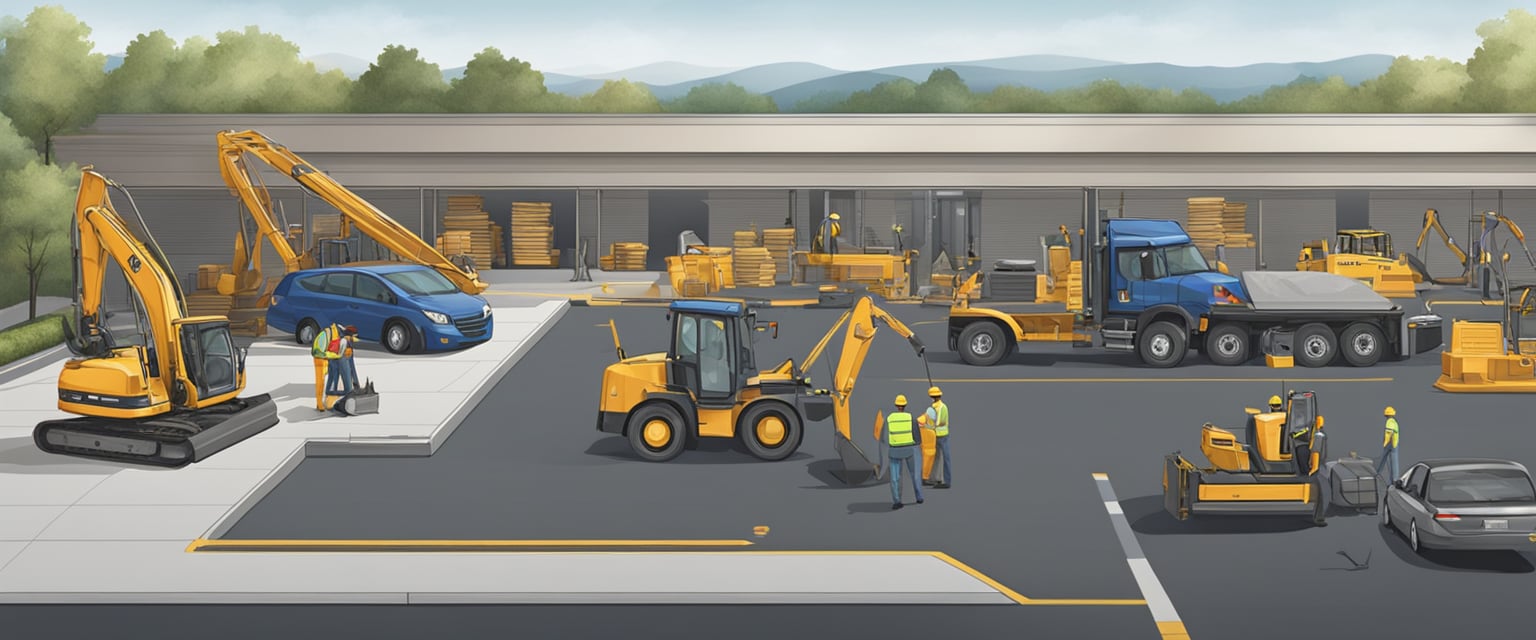
When considering a new parking lot installation or repair, questions about costs, materials, and processes are common. Addressing these can help in making informed decisions about the project.
How is the cost for paving a parking lot determined?
The cost for paving a parking lot is usually based on factors such as square footage, material choice, site preparation needs, and regional labor rates. Precise measurements and a clear understanding of the scope of work are crucial for accurate pricing.
What factors influence the commercial parking lot paving prices?
Commercial parking lot paving prices are influenced by the size of the area, existing pavement condition, required base materials, type of asphalt mixture, drainage requirements, and any special designs or markings that are needed.
What materials are commonly used for paving parking lots?
Asphalt is the most commonly used material for paving parking lots due to its durability and cost-effectiveness. Sometimes, concrete is used for areas that require additional strength, such as loading zones.
Which paving material is most cost-effective for parking lots?
Generally, asphalt is the most cost-effective material for parking lots as it is less expensive than concrete and can be installed more quickly, reducing labor costs. Additionally, maintenance for asphalt can be less costly over time.
Can you describe the process of paving a parking lot?
Paving a parking lot typically involves site preparation, which includes grading for proper drainage and laying a sub-base. Following this, an asphalt binder layer is applied, topped by a smoother asphalt surface layer. Finally, the parking lot is compacted and marked.
What considerations are important for parking lot pavement design?
Important considerations for parking lot pavement design include ensuring adequate slope for drainage, choosing the right asphalt mix for anticipated load and traffic, thickness of the asphalt layers, and compliance with local regulations for parking layouts and accessibility.


